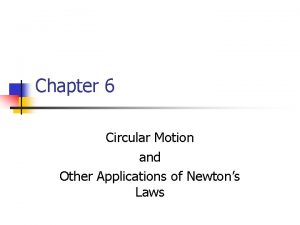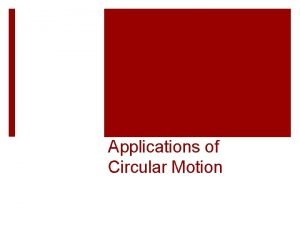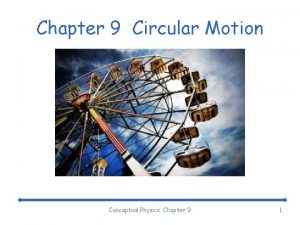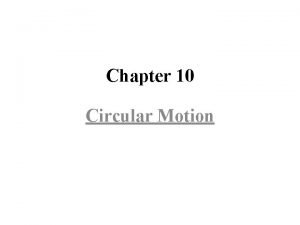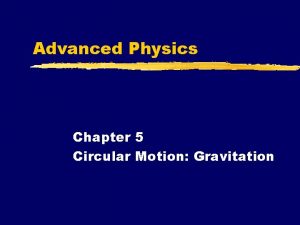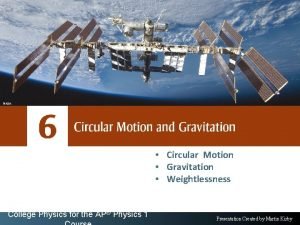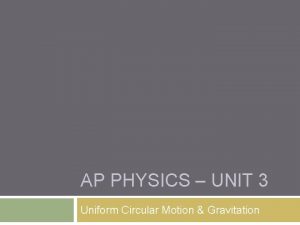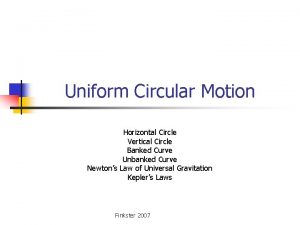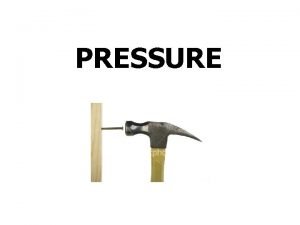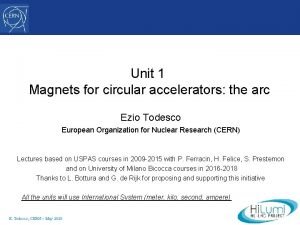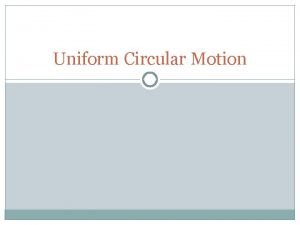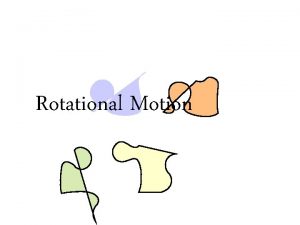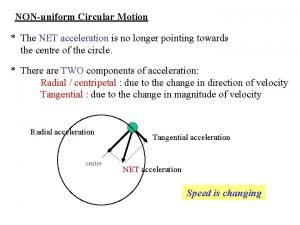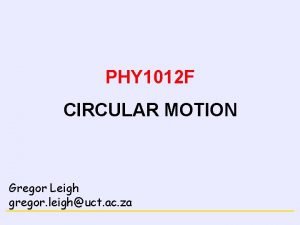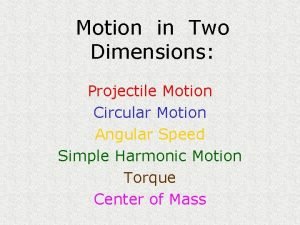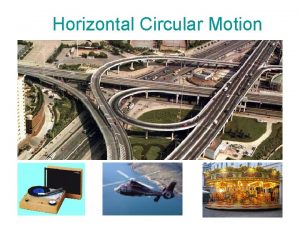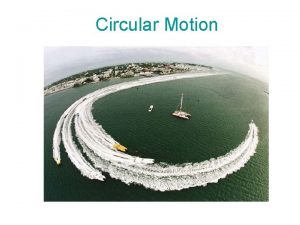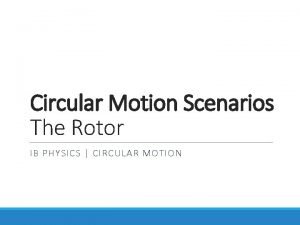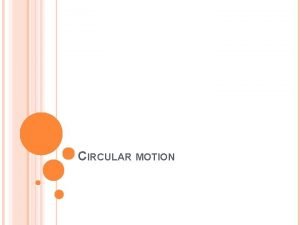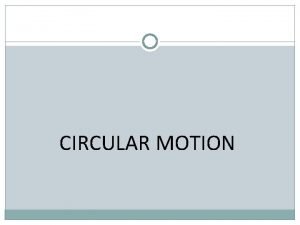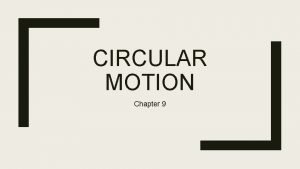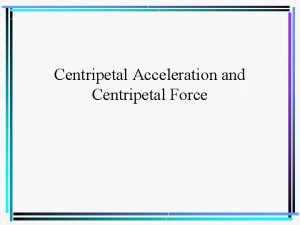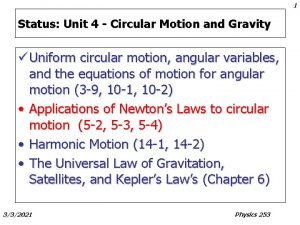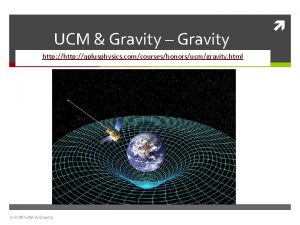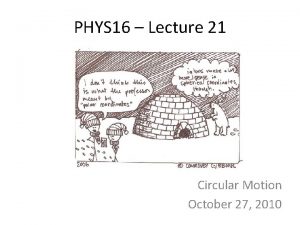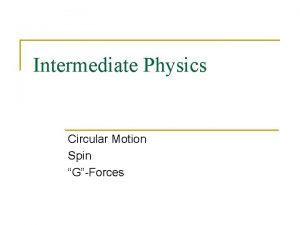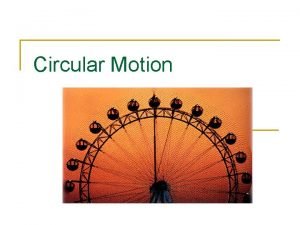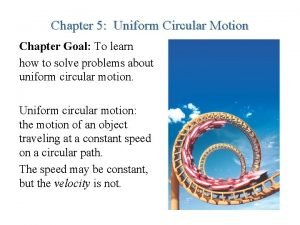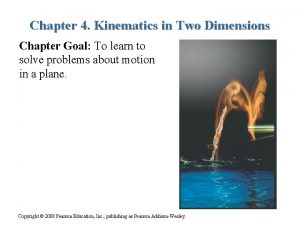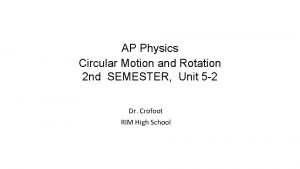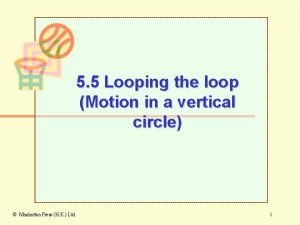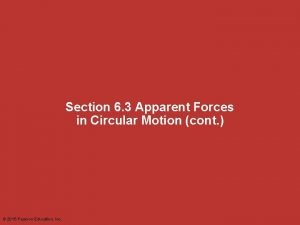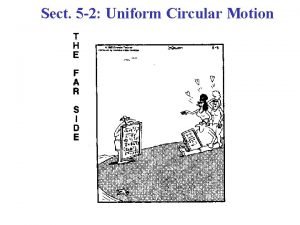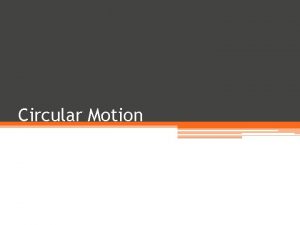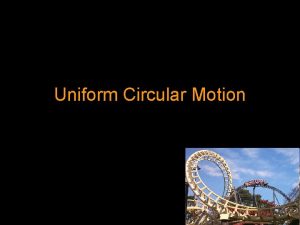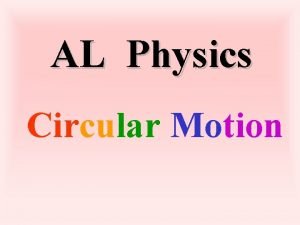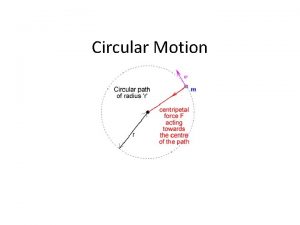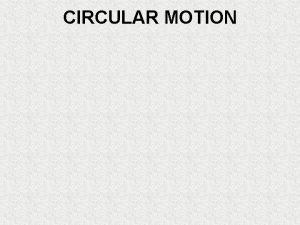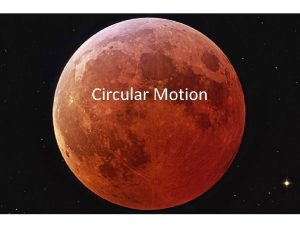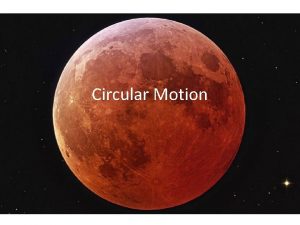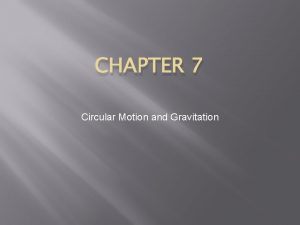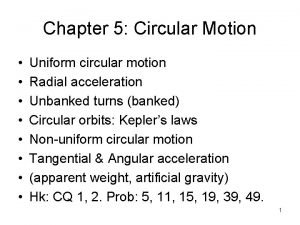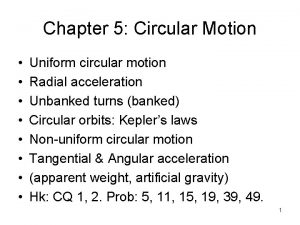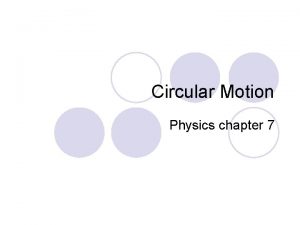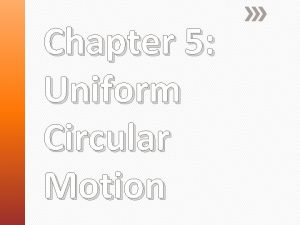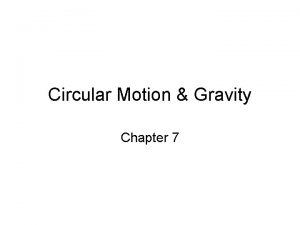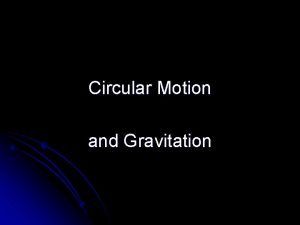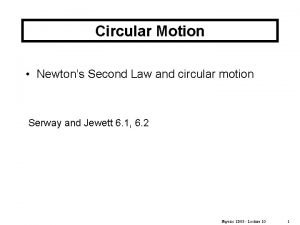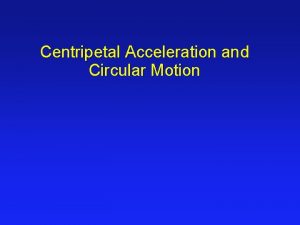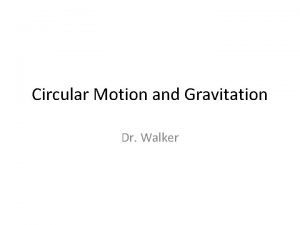Chapter 6 Circular Motion and Other Applications of









































- Slides: 41

Chapter 6 Circular Motion and Other Applications of Newton’s Laws

Uniform Circular Motion n A force, Fr , is directed toward the center of the circle This force is associated with an acceleration, ac Applying Newton’s Second Law along the radial direction gives

Uniform Circular Motion, cont n n n A force causing a centripetal acceleration acts toward the center of the circle It causes a change in the direction of the velocity vector If the force vanishes, the object would move in a straight-line path tangent to the circle

Centripetal Force n The force causing the centripetal acceleration is sometimes called the centripetal force n n This is not a new force, it is a new role for a force It is a force acting in the role of a force that causes a circular motion

Conical Pendulum n n The object is in equilibrium in the vertical direction and undergoes uniform circular motion in the horizontal direction v is independent of m

Motion in a Horizontal Circle n n The speed at which the object moves depends on the mass of the object and the tension in the cord The centripetal force is supplied by the tension

Horizontal (Flat) Curve n n n The force of static friction supplies the centripetal force The maximum speed at which the car can negotiate the curve is Note, this does not depend on the mass of the car

Banked Curve n n These are designed with friction equaling zero There is a component of the normal force that supplies the centripetal force

Loop-the-Loop n n This is an example of a vertical circle At the bottom of the loop (b), the upward force experienced by the object is greater than its weight

Loop-the-Loop, Part 2 n At the top of the circle (c), the force exerted on the object is less than its weight

Non-Uniform Circular Motion n n The acceleration and force have tangential components Fr produces the centripetal acceleration Ft produces the tangential acceleration SF = SFr + SFt

Vertical Circle with Non. Uniform Speed n The gravitational force exerts a tangential force on the object n n Look at the components of Fg The tension at any point can be found

Top and Bottom of Circle n n n The tension at the bottom is a maximum The tension at the top is a minimum If Ttop = 0, then

Motion in Accelerated Frames n A fictitious force results from an accelerated frame of reference n A fictitious force appears to act on an object in the same way as a real force, but you cannot identify a second object for the fictitious force

“Centrifugal” Force n n n From the frame of the passenger (b), a force appears to push her toward the door From the frame of the Earth, the car applies a leftward force on the passenger The outward force is often called a centrifugal force n It is a fictitious force due to the acceleration associated with the car’s change in direction

“Coriolis Force” n n This is an apparent force caused by changing the radial position of an object in a rotating coordinate system The result of the rotation is the curved path of the ball

Fictitious Forces, examples n n Although fictitious forces are not real forces, they can have real effects Examples: n n n Objects in the car do slide You feel pushed to the outside of a rotating platform The Coriolis force is responsible for the rotation of weather systems and ocean currents

Fictitious Forces in Linear Systems n n The inertial observer (a) sees The noninertial observer (b) sees

Fictitious Forces in a Rotating System n n According to the inertial observer (a), the tension is the centripetal force The noninertial observer (b) sees

Motion with Resistive Forces n Motion can be through a medium n n n Either a liquid or a gas The medium exerts a resistive force, R, on an object moving through the medium The magnitude of R depends on the medium The direction of R is opposite the direction of motion of the object relative to the medium R nearly always increases with increasing speed

Motion with Resistive Forces, cont n n The magnitude of R can depend on the speed in complex ways We will discuss only two n R is proportional to v n n Good approximation for slow motions or small objects R is proportional to v 2 n Good approximation for large objects

R Proportional To v n n n The resistive force can be expressed as R=-bv b depends on the property of the medium, and on the shape and dimensions of the object The negative sign indicates R is in the opposite direction to v

R Proportional To v, Example n Analyzing the motion results in

R Proportional To v, Example, cont n n n Initially, v = 0 and dv/dt =g As t increases, R increases and a decreases The acceleration approaches 0 when R ® mg n At this point, v approaches the terminal speed of the object

Terminal Speed n n n To find the terminal speed, let a = 0 Solving the differential equation gives t is the time constant and t = m /b

R Proportional To v 2 n n For objects moving at high speeds through air, the resistive force is approximately equal to the square of the speed R = ½ Dr. Av 2 n n D is a dimensionless empirical quantity that called the drag coefficient r is the density of air A is the cross-sectional area of the object v is the speed of the object

R Proportional To v 2, example n Analysis of an object falling through air accounting for air resistance

R Proportional To Speed n n The terminal speed will occur when the acceleration goes to zero Solving the equation gives 2 v, Terminal

Some Terminal Speeds

Process for Problem-Solving n Analytical Method n n The process used so far Involves the identification of well-behaved functional expressions generated from algebraic manipulation or techniques of calculus

Analytical Method n Apply the method using this procedure: n n Sum all the forces acting on the particle to find the net force, SF Use this net force to determine the acceleration from the relationship a =SF/m Use this acceleration to determine the velocity from the relationship dv/dt = a Use this velocity to determine the position from the relationship dx/dt = v

Analytic Method, Example n Applying the procedure: n n Fg = may = - mg ay = -g and dvy / dt = -g vy(t) = vyi – gt y(t) = yi + vyi t – ½ gt 2

Numerical Modeling n n n In many cases, the analytic method is not sufficient for solving “real” problems Numerical modeling can be used in place of the analytic method for these more complicated situations The Euler method is one of the simplest numerical modeling techniques

Euler Method n n In the Euler Method, derivatives are approximated as ratios of finite differences Dt is assumed to be very small, such that the change in acceleration during the time interval is also very small

Equations for the Euler Method

Euler Method Continued n n It is convenient to set up the numerical solution to this kind of problem by numbering the steps and entering the calculations into a table Many small increments can be taken, and accurate results can be obtained by a computer

Euler Method Set Up

Euler Method Final n One advantage of the method is that the dynamics are not obscured n n The relationships among acceleration, force, velocity and position are clearly shown The time interval must be small n n n The method is completely reliable for infinitesimally small time increments For practical reasons a finite increment must be chosen A time increment can be chosen based on the initial conditions and used throughout the problem n In certain cases, the time increment may need to be changed within the problem

Accuracy of the Euler Method n n n The size of the time increment influences the accuracy of the results It is difficult to determine the accuracy of the result without knowing the analytical solution One method of determining the accuracy of the numerical solution is to repeat the solution with a smaller time increment and compare the results n If the results agree, the results are correct to the precision of the number of significant figures of agreement

Euler Method, Numerical Example

Euler Method, Numerical Example cont.
 What causes circular motion
What causes circular motion Applications of circular motion
Applications of circular motion Circular motion conceptual physics
Circular motion conceptual physics Chapter 10 circular motion
Chapter 10 circular motion Chapter 5 circular motion gravitation
Chapter 5 circular motion gravitation Principles of hair design
Principles of hair design Chapter 2 section 1 describing motion answer key
Chapter 2 section 1 describing motion answer key Chapter 2 motion section 1 describing motion answer key
Chapter 2 motion section 1 describing motion answer key Section 1 describing motion
Section 1 describing motion Circulatory motion
Circulatory motion Ap physics unit 3 circular motion and gravitation
Ap physics unit 3 circular motion and gravitation Vertical
Vertical Other practical applications of boyle's law
Other practical applications of boyle's law Relativistic circular motion
Relativistic circular motion Uniform circular motion lab
Uniform circular motion lab Circular motion formula
Circular motion formula Net acceleration in circular motion
Net acceleration in circular motion Non uniform circular motion
Non uniform circular motion Normal force at top of loop
Normal force at top of loop Circular motion on banked road
Circular motion on banked road What is circular motion give two examples
What is circular motion give two examples Ib physics
Ib physics Rotational motion formulas
Rotational motion formulas Angular velocity formula
Angular velocity formula Circular motion definition
Circular motion definition Tension in a circular motion
Tension in a circular motion Non uniform circular motion
Non uniform circular motion Ucm gravity
Ucm gravity Acceleration in circular motion
Acceleration in circular motion Circular motion
Circular motion To gently combine two mixtures
To gently combine two mixtures Maximum velocity in vertical circular motion
Maximum velocity in vertical circular motion Circular motion conceptual questions
Circular motion conceptual questions Circular motion
Circular motion Dynamics of uniform circular motion
Dynamics of uniform circular motion What is the value of g on planet exidor?
What is the value of g on planet exidor? Ap physics circular motion
Ap physics circular motion Effects of looping the loop in circular motion
Effects of looping the loop in circular motion Circular motion is one dimensional or two dimensional
Circular motion is one dimensional or two dimensional Translational motion diagram
Translational motion diagram Physics textbook
Physics textbook Circular motion with constant speed
Circular motion with constant speed
